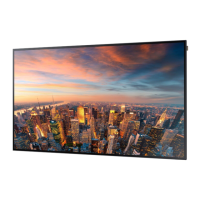Why does my Samsung DM82D Monitor screen keep switching on and off?
- SSteven AdamsAug 27, 2025
If your Samsung Monitor screen keeps switching on and off, check the cable connection between the monitor and PC, and ensure the connection is secure.

Why does my Samsung DM82D Monitor screen keep switching on and off?
If your Samsung Monitor screen keeps switching on and off, check the cable connection between the monitor and PC, and ensure the connection is secure.
How to adjust brightness on Samsung Monitor?
To adjust the brightness on your Samsung Monitor, adjust the Brightness and Contrast settings.
Why is there no sound coming from my Samsung DM82D?
If there is no sound from your Samsung Monitor, check the connection of the audio cable or adjust the volume. Also, check the volume level to ensure it is not muted.
How to fix a Samsung DM82D when the power LED is off and the screen won't turn on?
If the power LED is off and the screen doesn't turn on, ensure that the power cord is properly connected to your Samsung Monitor.
| Resolution | 3840 x 2160 (4K UHD) |
|---|---|
| Brightness | 350 cd/m² |
| Response Time | 8 ms |
| Viewing Angle | 178° (H) / 178° (V) |
| Panel Technology | VA |
| Built-in Speakers | Yes |
| VESA Mount Compatible | Yes |
| Connectivity | HDMI, DisplayPort, USB |
| Screen Size | 82 inches |
Important safety warnings and precautions for operating and cleaning the product.
Detailed explanation of remote control buttons, functions, and connection methods.
Methods for connecting a PC via D-SUB, DVI, HDMI, and DP cables.
Instructions for connecting video devices using AV, Component, and HDMI cables.
Methods for selecting and renaming input sources, and viewing device information.
Steps for installing MDC software and connecting to MDC via RS-232C or Ethernet.
Searching, playing, and scheduling content using the Player feature.
Setting up and customizing videowall displays, including format and screen position.
Selecting picture modes and adjusting backlight, contrast, brightness, and color.
Fine-tuning advanced picture settings like contrast, tone, noise filter, and motion.
Adjusting picture size, aspect ratio, and resolution for optimal display.
Selecting sound modes and configuring effects like virtual surround and dialog clarity.
Managing automatic source switching and power states like standby and saving.
Updating software and finding support contact information.
Playing photos, videos, music, and supported file formats.
Resolving installation, screen, sound, remote, and other product issues.
Product details: Model, Dimensions, Weight, Power Supply, and Environmental conditions.